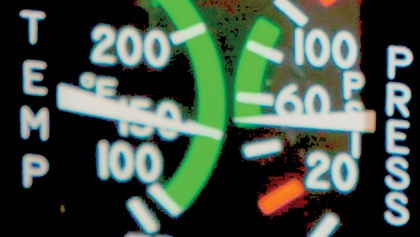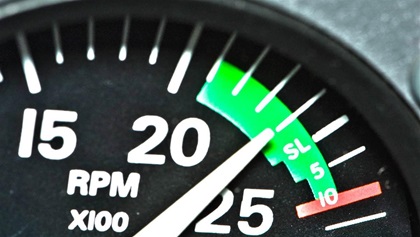Seeing red?
Engineers tested the limits so you don’t have to

We’re taught early in flight training that every airplane has a speed limit based on its structure, and that bad things happen if we exceed it. This is the never exceed speed, VNE.
But how is this speed determined? Is the prototype flown until its wings pop off, or nearly so, and that speed marked on the airspeed indicator?
Actually, no. According to Al Lawless, the technical council chair for the Society of Flight Test Engineers, a flight test engineer, and an FAA designated engineering representative, “The never-exceed speed is baked into the very structural design up front.” Lawless explains it this way: “Based on design goals set by the marketing department, CEO, or whoever, out pops a maximum cruising speed for normal operations. To certify the airplane, the manufacturer must show that if a pilot flies along at this speed and mishandles the flight controls or hits turbulence that pushes the plane into a dive, the maximum airspeed reached won’t be catastrophic. With this high airspeed in mind, engineers then design the vehicle to be just strong enough to recover without damage.”
FAA regulations require the structure to survive a certain percentage beyond the redline, as a safety margin. Does that mean there’s some wiggle room? Can you push the envelope on VNE? Lawless says, “VNE isn’t something to mess around with,” and even professional test pilots creep up on it. “Such testing is highly disciplined and includes careful buildups with engineering oversight, data review, parachutes—and, usually, a new airframe.”
Got it. But just out of feline curiosity, what happens north of the redline?
The answer, it turns out, is it depends. Flutter can set in and tear an airplane to pieces in minutes, or even seconds. Or, according to William F. O’Hara, an assistant professor of aeronautical science at Embry-Riddle Aeronautical University’s Prescott, Arizona, campus, dynamic pressure can turn an airframe “into confetti in a heartbeat.”
But other times the damage is subtler. An airplane can be bent, wrinkled, or weakened by exceeding the redline; and that’s actually the type of damage that worries O’Hara the most: a flight surpassing VNE by one pilot, damaging the aircraft to the point that a normal flight in the future by a different pilot will be the straw that breaks the airplane’s back. “There’s nothing wrong with going right to the limitation,” says O’Hara, “but don’t be a jerk and exceed those limitations, because some other poor shmuck will pay the price.”
Fast moving parts
What about that redline on the tach? How is the maximum speed of an engine determined? According to A&P/IA Mike Busch, founder and CEO of Savvy Aviation, it’s not the speed of the engine, but the speed of key moving parts inside of it—especially the pistons and their connecting components—that both accelerate and decelerate as the engine runs.
As with most redlines, the actual numbers are worked out “through a combination of analysis and test results,” and lean heavily on FAR 33.7, 33.43, 33.45, 33.47 and 33.49, say Lycoming engineers, speaking through the Avco Corp. communications department.
Warning: This section of the regulations is not light reading.
So what happens to the engine if you see red? It’s called an overspeed, and can damage the engine faster than you can complete your visual scan. Continental Service Bulletin SB05-2 defines an overspeed as running the engine over redline for more than 10 seconds, and says that overspeeds “can cause serious damage to the engine and can result in subsequent catastrophic engine failure.”
Post-overspeed maintenance can vary from minor inspections to major engine work, depending on how far over the redline the engine has gone—but it doesn’t take much. For example, going 575 rpm over redline—about 20 percent—on a Cessna 182’s Continental O-470 requires a complete engine teardown before further flight. And not just any teardown. In addition to a complete overhaul, Continental’s service bulletin instructs that “connecting rods, connecting rod bolts, and all valve train components must be replaced without consideration of normal wear tolerances.”
Ka-ching!
Hey, wait a second. Don’t race airplanes fly safely at higher rpm? Lawless says, “Race aircraft can bump up power by increasing rpm,” but points out that, “even if they also finely balance all rotating parts—something car racers call ‘blueprinting’—the increased duty cycle always reduces engine life.” Any serious fan of air racing has probably witnessed a race engine suffering a reduced life.
And speaking of engines blowing up….
 Don’t blow your top
Don’t blow your top
Busch says maximum cylinder head temperatures, and thus their redlines, are limited by two things: the strength of the metal in the head casting, and the strength of the head-to-barrel junction. He says the tensile strength of the aluminum alloy used in the casting “drops by about half at 400 degrees Fahrenheit, compared with room temperature,” and drops further “quite rapidly” as temperatures exceed 400 degrees. At the same time, the strength of the junction also drops with increases in temperature. That means small increases in temperature above the redline mean big trouble.
Busch says, “The CHT redlines set by engine manufacturers should be treated as emergency temperatures,” and says that these redlines have “little or no wiggle room in my opinion. If the pilot waits for CHT to reach redline, it’s too late to save the cylinder.” He reports that, “I’ve seen at least one case of a Continental IO-550 cylinder separating catastrophically after CHT exceeded the 460-degree redline by just a few degrees for less than one minute. One should never get anywhere close to CHT redline.”
Right. CHT is an engine’s VNE.
Hot oil might be fine for a massage, but not for your engine
I feel the need… the need for speedOK. Hot metal: bad. What about hot oil? Why the temperature redline for the oil system? O’Hare says it’s a matter of science: At high temperatures “the molecules separate so far from each other that the oil no longer provides protection.”
But if that’s the case, shouldn’t all oil redlines be the same? Actually, they’re close, with the typical Continental oil temperature redline at 240 degrees F, and the typical Lycoming at 245 degrees F; although Busch again says that the redlines are at the extreme end of the optimum. “The sweet spot for oil temperature is 180 to 200 degrees,” he says. “Much hotter than that reduces the life of the oil and necessitates more frequent oil changes; much cooler than that makes it difficult for the engine to boil off moisture from the oil sump, and encourages internal engine corrosion.”
The Lycoming engineers also point out that when oil is excessively hot there’s not only a reduction of viscosity, but also of oil pressure.
And speaking of pressure….
 Double whammy
Double whammy
Lastly, to the one instrument that has two redlines: the oil pressure gauge. We all know that if your engine oil pressure gets too low—generally from a loss of oil, but now we know that excessively hot oil may also cause pressure to drop—the engine seizes and you must land within your glide range. But what happens if the oil pressure goes too high? Lycoming says the excessive oil pressure can “cause damage to oil lines and other parts of the engine such as seals and gaskets, air/oil coolers, and hydro-mechanical parts such as wastegates.”
What on Earth would cause high oil pressure? The Lycoming engineering team says an improperly adjusted oil pressure relief valve, or something as simple as using the wrong grade of oil for the time of year, or throttling up before the oil is properly warmed.
But luckily—if such a thing could be said about blown engine gaskets—redline would be exceeded on the apron, not in the air. Says Busch, “Both of these limits refer to oil pressure during ground operations. The low redline pressure is the minimum necessary for engine lubrication at idle with hot oil, and the high redline pressure is the maximum that can be tolerated by the engine’s gaskets, O-rings, and other oil seals” at startup with cold oil.
Why the temperature redline for the oil system? O’Hare says it’s a matter of science: At high temperatures “the molecules separate so far from each other that the oil no longer provides protection.”In flight, oil pressure should be in the green arc. As to seeing red, “Oil pressure redlines are extremely wide, so it’s very difficult to exceed these redlines—either high or low—unless the engine is operated with extremely low oil level, or started in extremely frigid temperatures without a preheat,” Busch says, adding, “Neither of these events should ever happen.”
Seeing red yet?
So there you have it: Most redlines come to us from a blend of physics, materials analysis, testing, and regulation. And even though they contain varying degrees of safety margins, they are toyed with at risk to your airframe, your engine, and—frankly—your neck.
I guess it’s not without good reason that Mr. Scott in Star Trek wore a red shirt.
William E. Dubois is an aviation writer, world speed record holder, and two-time National Champion air racer. He teaches Rusty Pilots seminars for AOPA and blogs his personal flying adventures at PlaneTales.net.



